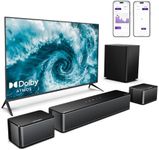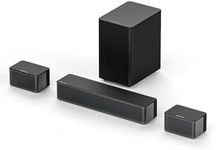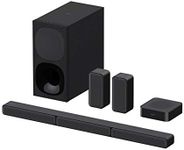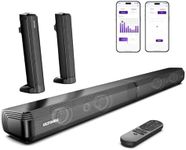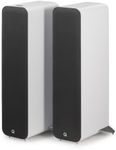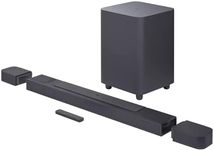Buying Guide for the Best Surround Sound Systems
Choosing the right surround sound system can greatly enhance your home entertainment experience. The key is to understand your needs and preferences, and then match them with the right specifications. Here are some important factors to consider when selecting a surround sound system.ChannelsChannels refer to the number of separate audio tracks that the system can play. Common configurations include 5.1, 7.1, and 9.1 channels. A 5.1 system includes five speakers and one subwoofer, which is suitable for most living rooms and provides a good balance of sound. A 7.1 system adds two additional speakers for a more immersive experience, ideal for larger rooms. A 9.1 system includes even more speakers for the ultimate surround sound experience, perfect for dedicated home theaters. Choose the number of channels based on the size of your room and how immersive you want your audio experience to be.
Speaker TypesSurround sound systems come with different types of speakers, including floor-standing, bookshelf, in-wall, and satellite speakers. Floor-standing speakers are large and provide powerful sound, suitable for spacious rooms. Bookshelf speakers are smaller and can be placed on shelves or stands, ideal for medium-sized rooms. In-wall speakers are built into the walls, offering a clean look and saving space, perfect for those who want a discreet setup. Satellite speakers are compact and can be placed around the room, making them versatile for various room sizes. Consider the layout of your room and your aesthetic preferences when choosing speaker types.
SubwooferThe subwoofer is responsible for delivering deep bass sounds, which add depth and richness to your audio experience. Subwoofers come in different sizes and power ratings. A larger subwoofer with higher wattage will produce more powerful bass, suitable for larger rooms or if you enjoy bass-heavy music and movies. Smaller subwoofers are adequate for smaller rooms or if you prefer a more balanced sound. Think about the size of your room and your bass preferences when selecting a subwoofer.
ReceiverThe receiver is the hub of your surround sound system, connecting all the speakers and managing the audio signals. Important features to look for in a receiver include the number of HDMI inputs, support for the latest audio formats, and built-in streaming services. More HDMI inputs allow you to connect multiple devices, such as a TV, gaming console, and Blu-ray player. Support for the latest audio formats ensures you get the best sound quality. Built-in streaming services provide convenience if you like to stream music or movies. Choose a receiver that matches your connectivity needs and desired features.
Room Size and AcousticsThe size and acoustics of your room play a significant role in how your surround sound system will perform. Larger rooms may require more powerful speakers and additional channels to fill the space with sound. Smaller rooms can achieve great sound with fewer speakers and lower power. Room acoustics, such as the presence of carpets, curtains, and furniture, can affect sound quality. Soft furnishings can absorb sound, while hard surfaces can reflect it. Consider the size and layout of your room, and if possible, test the system in your space to ensure it meets your expectations.
Wireless vs. WiredSurround sound systems can be either wired or wireless. Wired systems typically offer more stable and higher-quality sound, as there is no risk of signal interference. However, they require running cables around the room, which can be cumbersome. Wireless systems are easier to set up and offer more flexibility in speaker placement, but they may experience occasional signal drops or interference. If you prioritize sound quality and don't mind the setup, a wired system may be best. If you prefer convenience and flexibility, a wireless system could be the right choice.
